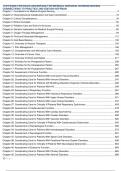Exam (elaborations)
TEST BANK FOR DAVIS ADVANTAGE FOR MEDICAL SURGICAL NURSING MAKING CONNECTIONS TO PRACTICE 2ND EDITION HOFFMAN
- Course
- Institution
- Book
TEST BANK FOR DAVIS ADVANTAGE FOR MEDICAL SURGICAL NURSING MAKING CONNECTIONS TO PRACTICE 2ND EDITION HOFFMAN Chapter 1: Foundations for Medical-Surgical Nursing .................................................................................................. 3 Chapter 2: Interprofessional Collab...
[Show more]



